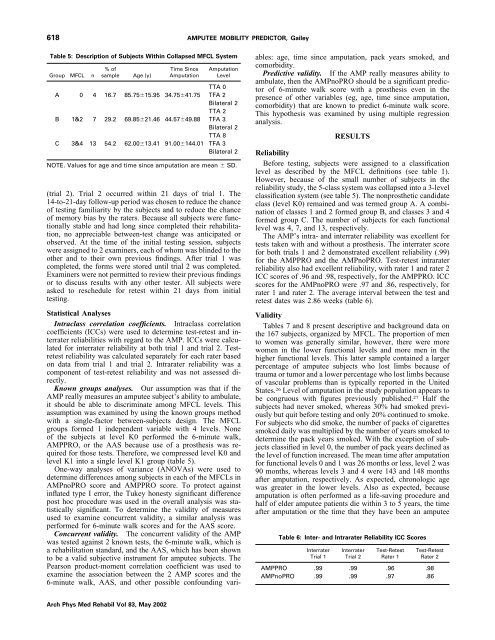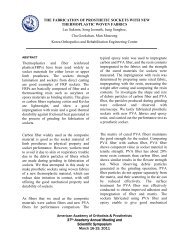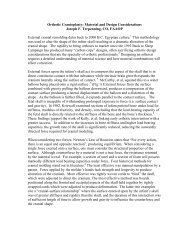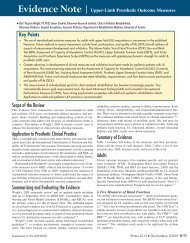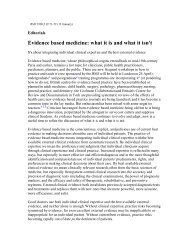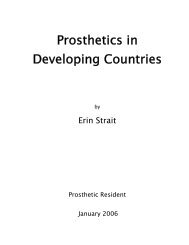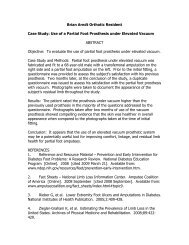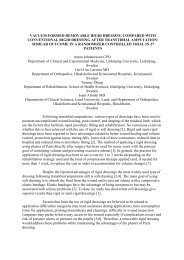The Amputee Mobility Predictor: An Instrument to Assess ...
The Amputee Mobility Predictor: An Instrument to Assess ...
The Amputee Mobility Predictor: An Instrument to Assess ...
Create successful ePaper yourself
Turn your PDF publications into a flip-book with our unique Google optimized e-Paper software.
618 AMPUTEE MOBILITY PREDICTOR, Gailey<br />
Table 5: Description of Subjects Within Collapsed MFCL System<br />
Group MFCL n<br />
%of<br />
sample Age (y)<br />
Time Since<br />
Amputation<br />
Amputation<br />
Level<br />
TTA 0<br />
A 0 4 16.7 85.75�15.95 34.75�41.75 TFA 2<br />
Bilateral 2<br />
TTA 2<br />
B 1&2 7 29.2 69.85�21.46 44.57�49.88 TFA 3<br />
Bilateral 2<br />
TTA 8<br />
C 3&4 13 54.2 62.00�13.41 91.00�144.01 TFA 3<br />
Bilateral 2<br />
NOTE. Values for age and time since amputation are mean � SD.<br />
(trial 2). Trial 2 occurred within 21 days of trial 1. <strong>The</strong><br />
14-<strong>to</strong>-21-day follow-up period was chosen <strong>to</strong> reduce the chance<br />
of testing familiarity by the subjects and <strong>to</strong> reduce the chance<br />
of memory bias by the raters. Because all subjects were functionally<br />
stable and had long since completed their rehabilitation,<br />
no appreciable between-test change was anticipated or<br />
observed. At the time of the initial testing session, subjects<br />
were assigned <strong>to</strong> 2 examiners, each of whom was blinded <strong>to</strong> the<br />
other and <strong>to</strong> their own previous findings. After trial 1 was<br />
completed, the forms were s<strong>to</strong>red until trial 2 was completed.<br />
Examiners were not permitted <strong>to</strong> review their previous findings<br />
or <strong>to</strong> discuss results with any other tester. All subjects were<br />
asked <strong>to</strong> reschedule for retest within 21 days from initial<br />
testing.<br />
Statistical <strong>An</strong>alyses<br />
Intraclass correlation coefficients. Intraclass correlation<br />
coefficients (ICCs) were used <strong>to</strong> determine test-retest and interrater<br />
reliabilities with regard <strong>to</strong> the AMP. ICCs were calculated<br />
for interrater reliability at both trial 1 and trial 2. Testretest<br />
reliability was calculated separately for each rater based<br />
on data from trial 1 and trial 2. Intrarater reliability was a<br />
component of test-retest reliability and was not assessed directly.<br />
Known groups analyses. Our assumption was that if the<br />
AMP really measures an amputee subject’s ability <strong>to</strong> ambulate,<br />
it should be able <strong>to</strong> discriminate among MFCL levels. This<br />
assumption was examined by using the known groups method<br />
with a single-fac<strong>to</strong>r between-subjects design. <strong>The</strong> MFCL<br />
groups formed 1 independent variable with 4 levels. None<br />
of the subjects at level K0 performed the 6-minute walk,<br />
AMPPRO, or the AAS because use of a prosthesis was required<br />
for those tests. <strong>The</strong>refore, we compressed level K0 and<br />
level K1 in<strong>to</strong> a single level K1 group (table 5).<br />
One-way analyses of variance (ANOVAs) were used <strong>to</strong><br />
determine differences among subjects in each of the MFCLs in<br />
AMPnoPRO score and AMPPRO score. To protect against<br />
inflated type I error, the Tukey honesty significant difference<br />
post hoc procedure was used in the overall analysis was statistically<br />
significant. To determine the validity of measures<br />
used <strong>to</strong> examine concurrent validity, a similar analysis was<br />
performed for 6-minute walk scores and for the AAS score.<br />
Concurrent validity. <strong>The</strong> concurrent validity of the AMP<br />
was tested against 2 known tests, the 6-minute walk, which is<br />
a rehabilitation standard, and the AAS, which has been shown<br />
<strong>to</strong> be a valid subjective instrument for amputee subjects. <strong>The</strong><br />
Pearson product-moment correlation coefficient was used <strong>to</strong><br />
examine the association between the 2 AMP scores and the<br />
6-minute walk, AAS, and other possible confounding vari-<br />
Arch Phys Med Rehabil Vol 83, May 2002<br />
ables: age, time since amputation, pack years smoked, and<br />
comorbidity.<br />
Predictive validity. If the AMP really measures ability <strong>to</strong><br />
ambulate, then the AMPnoPRO should be a significant predic<strong>to</strong>r<br />
of 6-minute walk score with a prosthesis even in the<br />
presence of other variables (eg, age, time since amputation,<br />
comorbidity) that are known <strong>to</strong> predict 6-minute walk score.<br />
This hypothesis was examined by using multiple regression<br />
analysis.<br />
RESULTS<br />
Reliability<br />
Before testing, subjects were assigned <strong>to</strong> a classification<br />
level as described by the MFCL definitions (see table 1).<br />
However, because of the small number of subjects in the<br />
reliability study, the 5-class system was collapsed in<strong>to</strong> a 3-level<br />
classification system (see table 5). <strong>The</strong> nonprosthetic candidate<br />
class (level K0) remained and was termed group A. A combination<br />
of classes 1 and 2 formed group B, and classes 3 and 4<br />
formed group C. <strong>The</strong> number of subjects for each functional<br />
level was 4, 7, and 13, respectively.<br />
<strong>The</strong> AMP’s intra- and interrater reliability was excellent for<br />
tests taken with and without a prosthesis. <strong>The</strong> interrater score<br />
for both trials 1 and 2 demonstrated excellent reliability (.99)<br />
for the AMPPRO and the AMPnoPRO. Test-retest intrarater<br />
reliability also had excellent reliability, with rater 1 and rater 2<br />
ICC scores of .96 and .98, respectively, for the AMPPRO. ICC<br />
scores for the AMPnoPRO were .97 and .86, respectively, for<br />
rater 1 and rater 2. <strong>The</strong> average interval between the test and<br />
retest dates was 2.86 weeks (table 6).<br />
Validity<br />
Tables 7 and 8 present descriptive and background data on<br />
the 167 subjects, organized by MFCL. <strong>The</strong> proportion of men<br />
<strong>to</strong> women was generally similar, however, there were more<br />
women in the lower functional levels and more men in the<br />
higher functional levels. This latter sample contained a larger<br />
percentage of amputee subjects who lost limbs because of<br />
trauma or tumor and a lower percentage who lost limbs because<br />
of vascular problems than is typically reported in the United<br />
States. 26 Level of amputation in the study population appears <strong>to</strong><br />
be congruous with figures previously published. 27 Half the<br />
subjects had never smoked, whereas 30% had smoked previously<br />
but quit before testing and only 20% continued <strong>to</strong> smoke.<br />
For subjects who did smoke, the number of packs of cigarettes<br />
smoked daily was multiplied by the number of years smoked <strong>to</strong><br />
determine the pack years smoked. With the exception of subjects<br />
classified in level 0, the number of pack years declined as<br />
the level of function increased. <strong>The</strong> mean time after amputation<br />
for functional levels 0 and 1 was 26 months or less, level 2 was<br />
90 months, whereas levels 3 and 4 were 143 and 148 months<br />
after amputation, respectively. As expected, chronologic age<br />
was greater in the lower levels. Also as expected, because<br />
amputation is often performed as a life-saving procedure and<br />
half of elder amputee patients die within 3 <strong>to</strong> 5 years, the time<br />
after amputation or the time that they have been an amputee<br />
Table 6: Inter- and Intrarater Reliability ICC Scores<br />
Interrater Interrater Test-Retest Test-Retest<br />
Trial 1 Trial 2 Rater 1 Rater 2<br />
AMPPRO .99 .99 .96 .98<br />
AMPnoPRO .99 .99 .97 .86


